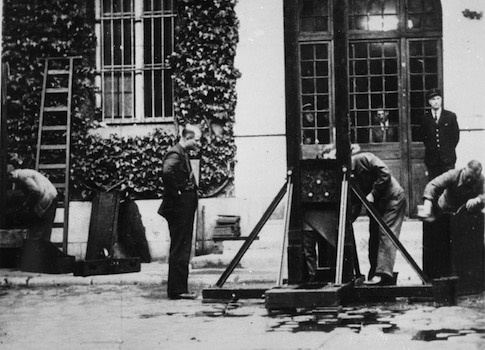When the horror cult classic Faces of Death (1978) was first released on video, the cassette cover came with a warning: "This feature contains graphic depictions of autopsies, dismemberment, physical cruelty, human combustion and electrocution. It should not be viewed by children, the elderly or the squeamish."
Perhaps something similar should have been done with Severed: A History of Heads Lost and Heads Found. Or at the very least smelling salts could’ve been tucked inside, considering such anecdotes as the early exploits of Viennese phrenologist Joseph Rosenbaum who, in 1808, decided he needed the skull of a recently deceased actress, Elizabeth Roose, for his collection.
"Ten days after Roose’s death … Rosenbaum, his friend Johann Peter and the local gravedigger met in the cemetery and dug her out…. ‘The foul smell beggars all description,’ Rosenbaum noted in his diary, ‘and we were actually concerned for the gravedigger’s life. She had begun to decompose so badly.’"
As author Frances Larson goes on to explain, "Roose’s flesh was swollen, greenish-black and yellow, and her bloated mouth hung open, revealing her teeth. Peter paid a doctor to excise the actress’s flesh and her brain, which were dumped into a bucket and buried in the garden while the two friends burnt incense furiously to try and disguise the stench. Then they put her skull and lower jaw into limewater and kept it in the garden for four months, by which time it was turning ‘spotted, wild and greenish’ and growing algae. This was a mistake."
You think? (Rosenbaum vowed to be more professional in his future pursuit of human skulls—he ultimately acquired one belonging to the composer Joseph Haydn.) And yet I found myself turning page after page in this history of man’s obsession with the human head.
It turns out I’m not alone. Decapitations and the like have always drawn a crowd. "Thousands crammed the streets, buildings and roofs of the Place de Grève," writes Larson, to witness the death of Robert-François Damiens in 1757 for his attempted assassination of King Louis XV. Who could resist watching the prisoner "tortured with molten lead and boiling oil before being pulled apart, slowly and ineptly, by horses, and then cut to pieces by the executioner"?
Larson devotes an impressive section to the introduction of the guillotine in 1792. As it turns out, witnesses were not impressed. "The machine was too quick and perfunctory; there was nothing to see." Whereas there was considerably more to see, hear, and feel in the pre-guillotine period. "There are stories of swords slicing through jaws and axes hacking into shoulder blades and skulls, and it taking two, three, five, even twenty attempts to dispatch the poor soul on the scaffold," writes Larson. "It took three blows to sever the head of Mary, Queen of Scots in 1587, and many more in 1541 to kill Margaret Pole, Countess of Salisbury, who defied her fate by refusing to place her neck on the block." (I would’ve opted for the block.)
But our obsession with heads isn’t limited to gory punishments. As Larson, an anthropologist at the University of Durham, points out, European colonialists were fascinated with headhunting culture, exchanging weapons and goods for native heads both shrunken (in the case of South America’s Shuar tribe) and life-size (as with the Maori toi moko of New Zealand). Larson notes the demand for heads was so high that natives began killing rivals outright just to trade their skulls for European wares. Catholics, meanwhile, continue to venerate the heads of holy figures such as St. Catherine of Siena and St. Oliver Plunkett, along with other relics—a finger here, a femur there.
In her chapter on trophy heads, Larson spends most of her time on U.S. soldiers during World War II who turned Japanese skulls into unseemly souvenirs. Japanese skulls acquired on the battlefield might have had "Made in Tokyo" inscribed on their foreheads, or even be autographed by a whole platoon before being sent home to a girlfriend—which led to a controversial photo in Life magazine in 1944. Larson claims that racism allowed for such behavior.
Larson, however, does not include the famous photo of Australian POW Leonard Siffleet, blindfolded and on his knees, with his Japanese captor standing behind him, sword raised in preparation for the decapitative deed. In fact, such Japanese atrocities aren’t mentioned at all, despite their relative frequency. In Ghost Soldiers, author Hampton Sides writes of "one notable mass execution in which 350 members of the Philippine 91st Army Division were herded up, tied with telephone wire, and systematically beheaded by sword."
Our obsession with heads continues to this day. But why? "The human head boasts one of the most expressive set of muscles known to life," Larson reminds us. Besides that, "We cannot confront another person’s head without sharing an understanding: face to face, we are peering into ourselves."
Larson writes about the equal sense of horror and wonder experienced by medical school students who must dissect a cadaver’s head (the process involves an electric saw). She investigates the cryogenic movement and details God-awful experiments, such as when Dr. Robert White of Cleveland "transplanted the head of one rhesus monkey onto the decapitated body of another." The monkey survived for some time and "tracked the movement of people and objects around the room, it bit people’s fingers, it chewed and tried to swallow food."
Unlike Faces of Death, in which many of the fatalities turned out to be staged, Larson’s stories are real, and they are equal parts disturbing and fascinating. Just be sure to have your smelling salts nearby.
